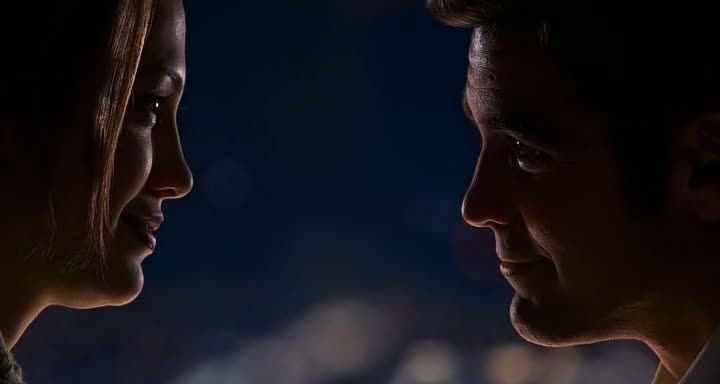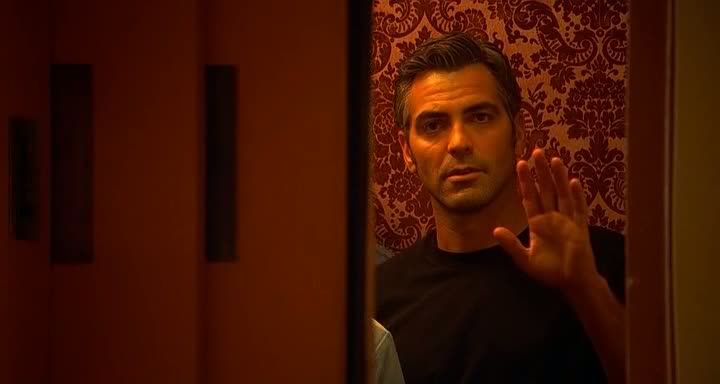
Out of Sight is the way sexy, charming, steamy star power movies are supposed to be. Steven Soderbergh's witty, beautifully filmed adaptation of an Elmore Leonard pulp novel is a throwback to classic Hollywood's casual stylishness and verbal sparkle, the kind of film that Hollywood isn't supposed to be capable of making anymore. The film is built around the mutual attraction between unrepentant bank robber Jack Foley (George Clooney) and the US marshal, Karen Sisco (Jennifer Lopez), who's trying to catch him. Or, more accurately, it's built on the charm, attractiveness and rapport of the two leads, who are at their most naturally charismatic here, radiating the self-assurance and sexiness that makes them irresistible both to each other and to audiences. Theirs is a mad love, a lunatic love built on seductive banter, utterly unbelievable in any conventional sense: why would a smart, capable woman dedicated to the law fall so deeply in love with the man who represents her complete opposite? But then again, why not? Clooney and Lopez are so attuned to one another, so comfortable in one another's presence onscreen, that the unbelievable is rendered not only plausible but unavoidable, fated, totally logical.
This romance arises from the time the pair spends in a trunk together after Jack kidnaps Karen during his escape from prison. This scene is the most iconic and oft-cited of the film, and justifiably so, as Soderbergh keeps his camera inside the trunk with the dirty, mud-smeared escapee and the elegant, reserved marshall, all dolled up and glamorous after a birthday dinner with her dad, ready for a date with her FBI agent boyfriend. A red light overlays the pair, and the cramped space of the trunk enforces their physical intimacy. Later, remembering the moment, Karen will tell Jack, "you kept touching me, feeling my thigh," and she sounds wistful, nostalgic, fondly recalling the time he kidnapped her. Soderbergh captures Jack's hand in closeup, tapping idly on Karen's hips, feigning casualness but obviously lingering a bit over the curved thigh beneath her skirt. Karen lays in the trunk with her back to her kidnapper, her curves pressed against him, seeming as relaxed as though she's just hanging out at home, although whenever she hears a police siren pass by her eyes grow alert. They chat amiably about crime and the law and the movies, their banter leading them towards a discussion of unlikely screen love stories, such as the one they're obviously about to enact.
Soderbergh's old-school stylishness is well-suited to this charming criminal love story. Nearly every frame pops with brilliant colors, and Soderbergh associates particular colors and images with certain moods and themes. The scenes of Jack and his partner Buddy (Ving Rhames) in prison are awash in the yellow jumpsuits of the prisoners, and the color-coding helps clarify the otherwise unannounced leaps into prison flashbacks. The present-tense scenes in Miami, on the other hand, are full of bright pastel hues: lurid orange walls, the red Hawaiian shirt Jack chooses as a disguise. A trip to Detroit for the film's second half is announced with a shot of a blue-tinged street scene, smoke drifting from a manhole cover, a grimly urban noir landscape that ushers in the outbursts of violence that punctuate the final act.
After Karen gets separated from Jack during his escape attempt, there's a sequence that turns out to be a dream in which she visits Jack's hotel, gun drawn, to find him lying naked in the bath, his eyes closed. Soderbergh emphasizes the orange walls, and shoots through the louvers of a nearby window as Karen creeps into her prey's hotel room. Then Jack grabs her, pulls her into the bath with him, and there's an indescribably sexy shot of her sitting on top of him, fully clothed, in the tub, kissing him and sinking into the water with him. It's a dream, but Soderbergh's style is so lurid and romantically overblown to begin with that it's as plausible as any of the things that actually do happen in the film. The film is itself a dream, a romantic fantasy, and he merely calls attention to that fact by throwing in an actual romantic dream like this.

Soderbergh's romanticism reaches its peak during the central love scene in which Jack finally catches up with Karen again, and they get to play out a real version of that dream, although the reality feels every bit as dreamlike. Jack finds Karen at a bar, just as he'd imagined during their first meeting, when he wondered aloud what would've happened if they'd met under different circumstances, like in a bar. He shows up like a vision after Karen has been hit on by a pair of determined advertising agents, the very opposite, in their professional respectability and conventionality, of bank robber Jack. Behind Karen, a huge glass window reveals snow falling, large fluffy flakes tumbling down in slow motion, and as Jack appears the bar around them becomes fuzzy, the city seen through the bar window as a blur of colored lights in the background. Jack's initial appearance is as a reflection in the window, and Karen turns towards him as though half-expecting that he won't be there, that she was just imagining his ghostly form superimposed over the nighttime city and the snow. Soderbergh's cutting cleverly draws out the moment, making the audience wonder, too, if Karen is just dreaming again; it takes a few more shots for the pair to appear together in the same frame.
They speak in hushed voices, as though they're hiding in plain sight, afraid of being caught, their desire aroused even more by the forbidden, furtive nature of their romance. Soderbergh captures their faces in beautifully lit closeups, their eyes shining, shy smiles constantly seeming to flutter at the edges of their lips. The actors have never looked better or seemed warmer or more natural; they are captured here at their best, flirting with one another, their characters flirting with one another, it hardly matters. It's delightful, and sexy as hell. It's some kind of glossy ideal of what love is supposed to be like, not the painfully banal notions of love advanced by so many other Hollywood romances but a real, deeply felt attraction that expresses itself in every least gesture, every word, every glance.
Their conversation is intercut with a scene in a hotel room afterward, as Jack and Karen eye each other from across a hotel room, taking turns stripping, Jack taking off his shirt to reveal a muscular chest, Karen slipping her dress over her head to reveal a shapely body in a bra and panties. Their bodies don't communicate as much as the looks they give each other, though, those intense stares from across the room. Then, and only then, does Soderbergh restore them to the intimacy they shared during that earlier trunk scene, as they come face to face in bed, their faces in profile and shadowed, a freeze frame holding them in place just inches apart. All the while, the snow continues to drift down in the background, and the light in the room is gorgeous and moody, enveloping the lovers in the romantically exaggerated hues that their mad love seems to require. Soderbergh will subtly evoke this scene again towards the end of the film, when the criminals' plans have gone awry and Karen, of course, comes face to face with Jack again, this time with a gun in her hand, facing him down as criminal and pursuer. Behind Jack, a large window frames a glimpse of the midnight blue night, with fluffy snow falling as it had on that other night.

The film has a lot to recommend it besides this stylish romanticism, of course. Soderbergh has assembled a cast of gifted comic actors who anxiously flit and dodge around the central couple. The colorful criminals and lawmen who provide the film's detail and its heist plotting include Dennis Farina as Karen's father, Steve Zahn as a stoned and hapless would-be robber, and Luis Guzman as an alternately sinister and silly criminal whose scene with Catherine Keener's Adele starts out threatening but abruptly becomes surprisingly comic. Michael Keaton shows up for another very funny cameo, reprising his role as federal lawman Ray Nicolette, the character he played in Quentin Tarantino's Jackie Brown, another Leonard adaptation. It's a nice nod, because while Soderbergh's film strikes a very different balance from Tarantino's — tilting more fully towards romance and away from tragicomic violence as compared with Tarantino's much darker vision — the two films have in common their moodiness and their commitment to slow-burn pacing and sharply defined characters.
In fact, Out of Sight is best summed up by a small, subtle moment that occurs between its two central characters without a word being spoken. At one point, Karen is tagging along on a raid meant to capture Jack and Buddy. She's staking out downstairs while the rest of the federal agents storm the robbers' room, but while she's waiting in the lobby she notices, across the room, Jack and Buddy standing in an elevator, its doors about to close and take them down to the parking garage. She raises her walkie-talkie to her lips but then pauses, and lets her hand drop away as she simply watches until the door close. Soderbergh cuts away from the closeup of her to show Jack, as the doors are closing, tentatively raising his hand as if to wave, not the cocky, show-off wave of a cheeky movie criminal, but the genuinely confused wave of a guy who's acting nervous around a girl he really likes. It's a funny moment, but not as broadly funny as it might have been if Soderbergh had exaggerated the gestures or played it a little differently. This way, it's not broadly comic but natural and genuine, an expression of the pleasant confusion that these two soon-to-be lovers feel when in each other's company. That repartee, visual and silent as well as verbal, is the essence of Out of Sight, and it's that warmth, that real spark of attraction and wit, that makes it such a special and delightful film.








0Awesome Comments!